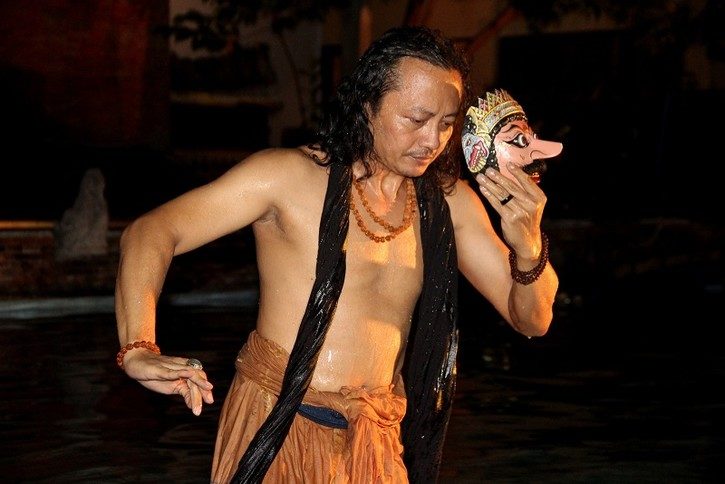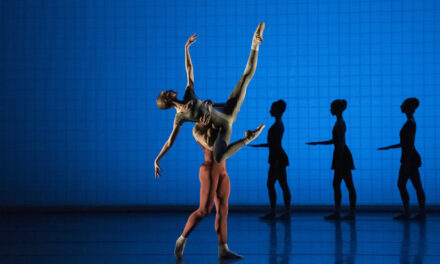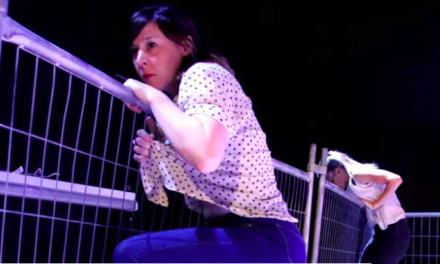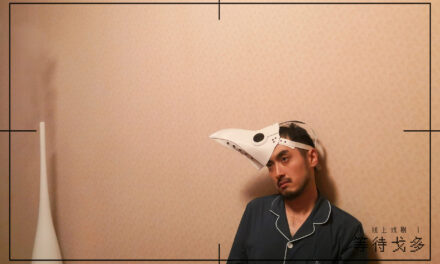As an event it was spectacular; as dance, it swirled past the barriers of culture and language. As theatre it was emotional, and of the highest quality.
But few shared the moving experience. The location was the small Panji Museum set among rice paddies in Tumpang village, East Java. There were maybe 150 in the audience. The Panji plays bring to life ancient Javanese tales. The museum aims to build an appreciation of the arts in general and this genre of storytelling in particular. The centerpiece of the museum is a replica of the one-thousand-year-old Candi Jolotundo, the royal bathing pool on sacred Mount Penanggungan, about 100 kilometers north-west of Tumpang.
Choreographer Matheus Wasi Bantolo arrived in Tumpang from Central Java just a few hours before he and twenty-five local and visiting dancers were to perform.
“At first, I decided to stay on the stage,” he said. “Then I wondered how to use the foreground, to get closer to the audience. I thought it might make the show more dramatic.”
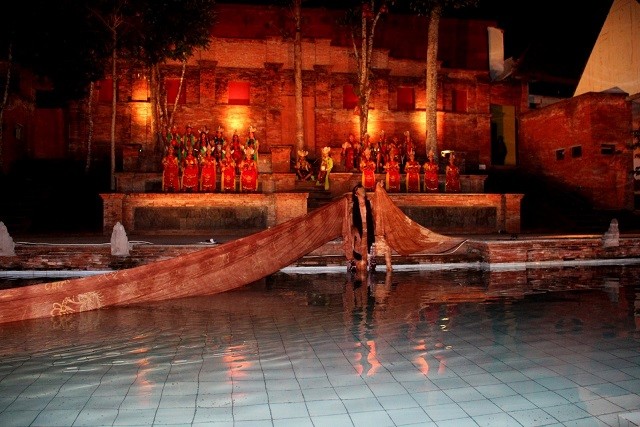
Indeed. Bantolo started his masked dance Kidung Kayungyun at the water’s edge then moved into the shallow pool, which is fed by a mountain stream. Bantolo said the dance’s Javanese title was difficult to translate but implied being “ensnared by personal feeling, like love or revenge.” “I developed it from a contemporary mask performance we staged earlier in Singapore and Thailand,” he added.
In a master-stroke during the performance, Bantolo scooped out a long fishing net on his left, then another from the right, while singing accompanied by a gamelan orchestra. It looked like a biblical tableau of casting nets to feed the multitude. Even without flapping fish it was a powerful image. Though Panji’s stories are claimed to have originated in East Java, many are found throughout Southeast Asia. In Thailand, they are called Inao. Nationalists claim that this shows that Java is the origin of much Asian art, rivaling India, the source of the epic performance poems Ramayana and Mahabharata.
The stories’ themes are universal; think Romeo and Juliet. Boy, Panji Inu Kertapati, Prince of Jenggala, meets girl, Dewi Sekartaji, princess of the Kediri Kingdom. He’s already engaged to be married to someone else, but guess what – they tumble into love.
Crisis! Dewi disappears on their wedding day. Did she know about the other woman, did she get cold feet or was she spirited away by a foe? Panji sets out to retrieve his true love. He confronts rivals, fights assailants and triumphs as befits a gallant hero. This gives space aplenty for sideways romps into intrigue, faith, politics, threats, morality, gender, and what it means to be human.
Spoiler alert: Dewi transforms herself into a man, Panji Semirang. Will her lover be duped? (Think Rosalind in Shakespeare’s As You Like It.)
The Panji Museum is being developed by Malang entrepreneur Dwi Cahyono, 51, to promote Indonesian culture and history focusing on Central and East Java. Displays in the museum take visitors on a journey that starts with a re-creation of an archaeological dig and leads to the present day through a labyrinth of fact and myth.
To help attract the crowds, Cahyono has included a swimming pool and a picnic ground, which can only be accessed through the artifact-filled auditorium. Visitors get shanghaied by history like air travelers get ambushed by duty-free shops as they head for the boarding gate.
Some of Cahyono’s ideas were gleaned during a 2016 tour of New Zealand, which included a visit to the National Museum Te Papa, and to film director Peter Jackson’s Weta Workshop in Wellington, used to make props for The Lord of the Rings films.
“Culture should be central if international relationships [with the West] are to be improved,” said Bantolo, a lecturer at the Institut Seni Indonesia (ISI, the Indonesian Arts Institute) in Solo, Central Java.
“Some mask dances are nearly extinct; maybe 50 percent of Indonesians don’t know the culture. We are trying to conserve and revive and make the stories more popular through contemporary choreography. But kayungyun (being trapped by emotions) remains the base.”
Culture as Conduit to the World
The ISI established a Centre for World Dance Studies to promote masked dancing and attract overseas students. Bantolo has performed in the Netherlands, Great Britain, and Germany, and was a guest lecturer at Michigan State University. He plans to enroll for a Ph.D. at Royal Holloway, University of London, next year.
“The Panji tales [for us] are not simply a love story between Panji and Dewi, though that’s been the standard interpretation,” he said.
“Rather we always keep an eye on what we feel is the story’s higher humanity. So throughout our creative process, we hold on to the cultural symbols reflected in the Panji narrative.
“These include keblat papat, the Javanese interpretations of the four points of the compass and their associated elements and how they maintain harmony and balance. Then there’s the interplay of the macro[cosmos and micro-cosmos, agrarian culture, and the arts of carving and painting masks; all are sources for our creative ideas.
“The challenge is to reflect these ideas differently – as a cultural dialogue. The dance movements are drawn from the court styles of the Keraton Surakarta (Solo Palace Court) and the Pura Mangkunegaran (Sultan’s Palace).
“Our innovations include sharing masks between multiple dancers. The story is told through tembang (sung poetry) and monologues. It’s a mix of theatre, opera, and dance.”
Bantolo, 43, was brought up in a liberal Catholic family of creatives who allowed him to choose a career. His grandfather was a dalang (puppet master). Bantolo himself was playing in the gamelan at 10 years old.
He said an early reference to masks in performances appeared in an eleventh-century manuscript from the royal court of Jenggala. (The short-lived kingdom was probably located at Sidoarjo near Surabaya.)
“To mask can mean to hide one’s face or wear a different face, an imitation,” he said.
“A mask can represent a certain personality, a community or the values of a cultural system. By wearing masks, rather than hiding, we expose and explore something about the reality of the human condition.
“I want the world not just to enjoy and respect our creativity, but to understand what’s behind our culture and the way we think and feel. Indonesians are close to nature and the universe. We have so much to share.”
This article originally appeared on Inside Indonesia on December 21, 2017 and has been reposted with permission.
Author: Duncan Graham
This post was written by the author in their personal capacity.The opinions expressed in this article are the author’s own and do not reflect the view of The Theatre Times, their staff or collaborators.
This post was written by Duncan Graham.
The views expressed here belong to the author and do not necessarily reflect our views and opinions.

